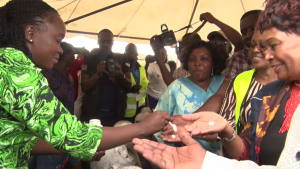The Government has launched a five-day mass drug administration (MDA) campaign towards eliminating intestinal worms and bilharzia in Kakamega.
Together with partners who include World Health Organization (WHO), Amref Health Africa, African Institute for Health and Development (AIHD), PATH and The END Fund, the government targets to reach at least 1.8 million people in the campaign.
The exercise will be carried out by the over 4,250 Community Health Promoters (CHPs), who will visit homes and public gatherings to administer the drugs ensuring maximum coverage.
Intestinal Worms and Bilharzia are among 20 Neglected Tropical Diseases (NTDs) identified by the World Health Organization (WHO).
The diseases are classified as neglected because they are almost absent from the global health agenda, receive little funding and are associated with stigma and social exclusion.
The NTDs, according to WHO, affects more than one billion people globally contributing to 534 000 annual deaths and cost developing economies billions of dollars annually.
Speaking during the launch of the MDA at Malava on Friday, Health Cabinet Secretary Dr. Deborah Barasa, said that NTDs undermine individual health and community potential even as WHO notes that up to 90 per cent of the total NTD disease burden occur in African region with some of those disease conditions being endemic only in Africa.
The CS said that Kenya faces a significant burden of NTDs that include Lymphatic Filariasis (LF) commonly known as elephantiasis, schistosomiasis, trachoma with over 25million people at risk of infection.
She said that the government has however made notable progress in managing NTDs including the elimination of Guinea Worm in 2017.
Dr. Barasa noted that Kakamega county Government has been instrumental in fighting the diseases achieving remarkable outcomes in the past one year where over 100 000 residents have received treatment for elephantiasis and schistosomiasis through MDAs campaigns.
“Additionally, the county government has had 200 community health sessions to raise awareness about NTD prevention and improved sanitation practices in 50 villages which have led to a 20 per cent reduction in trachoma prevalence,” Dr. Barasa added.
The recently launched NTD Master Plan 2023-2027, the CS said, provides a strategic framework for prevention, control, elimination and eradication of targeted NTDs.
“Addressing NTDs not only saves lives but also unlocks economic opportunities driving Kenya closer to its broader development goal. Partnership is essential in sustaining this momentum and I urge all stakeholders to support through innovative financing and precision public health strategies,” she added.
She said that the Kakamega county’s progress in strengthening Primary Health Care(PHC) and addressing NTDs is a beacon of hope, demonstrating the power of united efforts under a shared vision of health for all.
The CS added that the strengthened PHC in Kakamega through the establishment of 12 targeted Primary Healthcare Networks (PCNs) is transforming healthcare delivery in the region.
The PCNs have led to improved Immunization coverage in the county by 15 per cent, ensuring that more children are protected against preventable diseases.
They have also enhanced referral and outreach with over 2,000 patients referred for specialized care in the past one year.
“Community Health teams have also made a significant impact by visiting over 50 000 households bringing essential healthcare services directly to residents and strengthening healthcare delivery,” the CS noted.
“My ministry is committed to providing technical assistance advocating for sustainable financing and fostering inter-county knowledge sharing to enhance PCN implementation,” she explained.
The CS also noted that the establishment of Primary Care Networks has enabled key advancement in disease screening and management with over 10 000 individuals screened for conditions such as diabetes, hypertension, and 1,200 successfully managed.
“The roll out of Electronic Community Health Information System (ECHIS), marks a significant digital health advancement with a patient record of over 30 000 residents in Kakamega now digitized enhancing efficiency and data accuracy,” she disclosed.
Kakamega Governor Fernandes Barasa, through a speech read on his behalf by Deputy Governor Ayub Savula, noted that to achieve the Universal Health Coverage (UHC) agenda, the county government has worked very closely with the national government and other stakeholders to implement Primary Healthcare Act 2023 in line with the WHO health building blocks.
“So far, we have established and gazetted 12 Primary Healthcare Networks (PCNs) with available structure fully in place. This is expected to significantly enhance health service delivery to our people,” the governor said.
He also noted that the outreach and in reach services witnessed, are game changers in reducing out of pocket healthcare expenditures by bringing specialized services closer to unreached populations.
“I am delighted that we are launching a community wide deworming campaign targeting intestinal worms and bilharzia. I encourage everyone to participate in this exercise, by doing so we are also working towards the reduction of parasitic worms, breaking the cycle of transmission within the community,” he noted.
By Moses Wekesa









